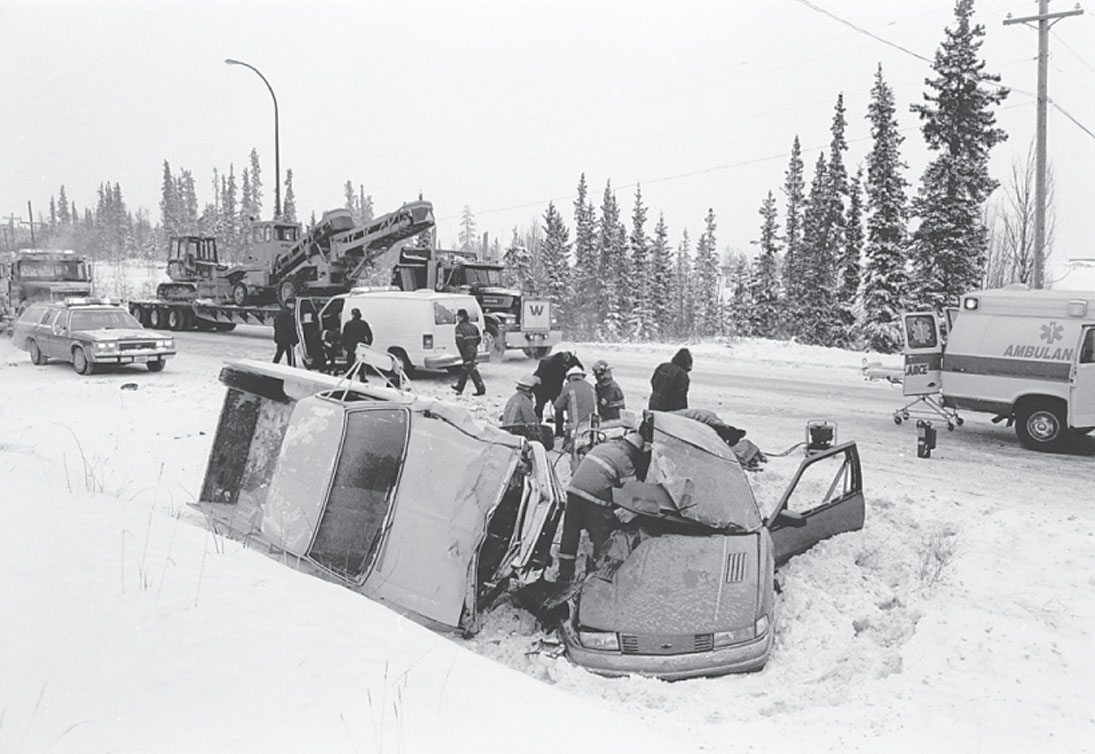Collision called Yukon's worst-ever
The circumstances surrounding what's being called the Yukon's worst-ever highway tragedy early Friday afternoon remain uncertain today. The accident killed six Carcross residents.
By Whitehorse Star on December 4, 1995
RCMP Cpl. Ross Milward said police investigators are not sure what caused a car jammed with eight passengers to spin out of control about 1:45 p.m. along the Alaska Highway, half a kilometre south of the South Access Road intersection.
Four children and two adults were killed and two others were taken to hospital when their northbound Chevrolet Lumina crossed the centre line and was broadsided on the passenger's side by a southbound Dodge four-by-four pickup, the officer in charge of highway patrol told a press conference this morning.
Killed instantly were driver Karen Bayne, 29, Susan Bayne, 27, Karen's 23-month old daughter, Jaclyn Bayne, and Susan's three-month-old son, Elijah Bayne-Sawrenko.
Five-year-old Miranda Bayne-Sawrenko, Susan's daughter, died en route to hospital. Nine-year-old Jacy Johnson, Karen's daughter, died in hospital at 1:25 a.m. Saturday.
Karen's nine-year-old daughter, Shayla Johnson, was taken to hospital but was not admitted. Her eight-year-old son, Slade Johnson, was admitted for treatment but was released Sunday.
Shayla and Slade were seated on the left hand side of the rear seat, furthest from the point of impact.
Paul Gignac, the driver of the truck, was admitted to hospital where he's recovering from chest injuries, Millward said. Gignac was wearing his seat belt.
The RCMP M Division's accident reconstruction expert understands that only one of the eight Lumina passengers was wearing a seat belt. In this accident, however, he does not believe seat belt use would have made much of a difference.
"This collision was of such a magnitude and there was so much intrusion, I do not believe that anybody in the front would have survived."
Milward said in his 18 years working traffic accidents, he's never experienced this many fatalities in one accident.
"From anybody I have talked to, it is probably the worst in Yukon history."
The road conditions at the time are being described by Milward as icy, although he's unable to say now how much of a factor road conditions were.
Driver Karen Bayne was thrown from the vehicle. The three other front seat passengers, Susan Bayne and the two youngest children, were also killed on impact.
Milward said Susan was apparently the only passenger wearing a seat belt, but it was torn in half in the collision.
The force of the impact was so great, the corporal noted, that the passenger side of the vehicle was pushed over to the mid-way point of the steering wheel.
"In this particular situation, seatbelts are not that effective in side impacts."
Milward doubts whether the front seat passengers would have survived even if the vehicle had been equipped with side-impact air bags.
This crash was made worse by the fact that the centre of mass of both vehicles hit directly. That means there was no spinning off of each other, he explained. Rather, the vehicles locked together and stayed together until they came to a stop in the ditch on west side of the highway.
The impact occurred near the shoulder of the southbound lane.
There is an indication the driver of the truck had begun turning toward the ditch to avoid the collision, Milward said.
The investigation will continue with further interviews of those involved, as well as the driver of a vehicle who was travelling ahead of the Lumina and noticed the vehicle fishtailing shortly before the crash.
Police were to conduct a test later today to determine if any of the other occupants were wearing seat belts. Milward said a mechanical evaluation of the vehicle will be done when temperatures warm up to determine if there was any mechanical failure of brakes or such that may have contributed.
Until he can complete a more detailed analysis of information gathered at the scene, he's unable to say precisely how fast the vehicles were travelling.
But he said his experience in assessing the damage to the two vehicles indicates to him the vehicles were travelling regular highway speeds - about 90 - 100 kilometres an hour.
By Chuck Tobin

Be the first to comment